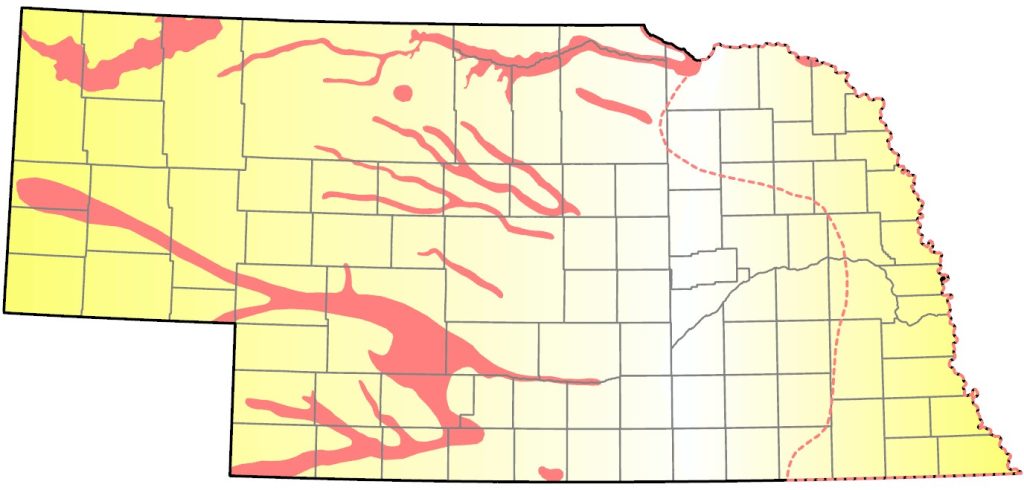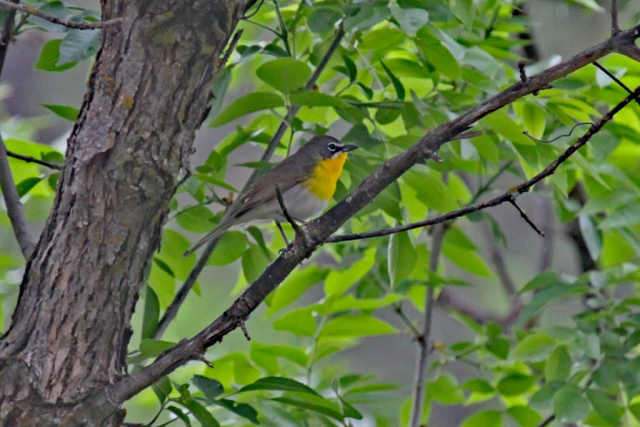Icteria virens virens, I. v. auricollis
Status: Uncommon, locally common, regular breeder and spring and fall migrant west and central, rare east.
Documentation: Specimens: auricollis, UNSM ZM6909, 3 Jun 1901 Monroe Canyon, Sioux Co; virens, UNSM ZM10757, 15 May 1909 Roca, Lancaster Co.
Taxonomy: Recent genetic studies resulted in assignment of this species to its own family, Icteriidae; it is no longer considered a member of Parulidae (Chesser et al 2017).
Two subspecies are recognized (AviList 2025): auricollis, breeding from the western Great Plains (including southern Saskatchewan) and western Texas westward, and virens, breeding in the eastern portion of the range, from the eastern Great Plains (northeastern South Dakota; AOU 1957) and central Texas (Fort Worth, Houston; AOU 1957) eastward.
Both subspecies breed or have bred in Nebraska, although the breeding population in southeastern Nebraska, presumably virens, has declined in recent years and appears to have been extirpated (see Summer). Perhaps most of the few but increasing number of recent reports of Yellow-breasted Chat in the east are of western auricollis rather than recolonizing virens; a specimen of auricollis that had probably died 26 Sep 2018 was picked up on the University of Nebraska-Lincoln campus 28 Sep 2018 (Thomas Labedz, personal communication) and one in Wayne Co 13 May 2025 was identified as auricollis based on its expansive white malar (Strand, eBird.org). There are two old specimen records of auricollis in the east: one (UNSM ZM6912) from Adams Co 10 May 1919 (Jorgensen 2012), and another (HMM 2634-A) from Clay Co 18 May 1920 (Jorgensen 2012, Swenk 1940). There are only four recent documented records of virens in Nebraska (eBird.org, accessed Jun 2025), three of which, oddly, are from the Panhandle: Wind Springs Ranch, Sioux Co 18 May 2022, Ash Hollow SHP, Garden Co 27 May 2019, and near Oshkosh, Garden Co 4 Jun 2020. The fourth is a recording in Douglas Co 22 May 2024. There are several records, including specimens, of virens in northeastern Colorado (Steven Mlodinow, personal communication).
A study by Canterbury (2007) of acoustic properties of Yellow-breasted Chat songs along the Niobrara River in the general area of the subsequently constituted Chat Canyon WMA, Cherry Co, indicated that chats in this area, presumably of the western subspecies, vary certain components of their songs depending on geographic location as it relates to habitat and time of day.
Changes since 2001: This species was essentially extirpated from the southeast by 2000, but since then reports have increased. Of 27 southeasterly reports for May-Jul for 1981 through 2017, 22 occurred since 2008.
Spring: May 2, 2, 2 <<<>>> summer
Spring migrants arrive in in early May and are common in the west, but there are few but increasing reports in the east. Recent increases in the number of eastern reports may be explained either by western auricollis expanding eastward or a return of eastern virens to its former range (see Taxonomy).
One in the observer’s Dixon Co yard 21 May 2009 was the first there since 1996 (Jan Johnson, personal communication), one was at Arbor Day Farm, Otoe Co 8 May 2011, and one in Dakota Co 28 May 2013 was the veteran observer’s first for that county (Bill Huser, personal communication). Beginning with a southeastern influx in 2014 of 3-4 birds 16 May-1 Jun, subsequent years have increasing reports, including at least seven reports 10-22 May 2022, an impressive 15 reports involving a total of 16 birds 10-31 May 2023, and nine reports 3-28 May 2024.
- High counts: 23 along Old Stage Road, Scotts Bluff Co 30 May 2024, 22 at Rock Creek SRA, Dundy Co 26 May 2019, and 21 at Buffalo Creek WMA, Scotts Bluff Co 27 May 2024.
Summer: This species was formerly considered to be most common in the eastern part of the state; Bruner et al (1904) listed it as “abundant” along the eastern edge and Mollhoff (2022) cited three nests with eggs in Douglas and Sarpy Cos 25 May-5 Jun 1893-1898. By 1958, Rapp et al (1958) described the species as fairly common throughout, most numerous in the east, especially in the Missouri River Valley, but also in the valleys of the Little Blue and Elkhorn rivers (Swenk 1940). As late as the 1970s, it was distributed statewide (Johnsgard 1979), but numbers of Yellow-breasted Chats declined significantly range-wide during 1966–1988 (-1.33%, p < 0.01), mostly in the eastern USA (-2.06%, p < 0.01; Sauer and Droege 1992, Eckerle and Thompson 2020), including eastern Nebraska (Sharpe et al 2001). Although Ducey (1988) has proposed that destruction of nesting areas along the Missouri River due to riverside development as a cause for this decline, an additional explanation is that this eastern population, presumably virens, experienced limiting factors that reduced numbers in its wintering range similar to those experienced by other eastern neotropical migrants (Terborgh 1989). Chat numbers in eastern Kansas declined to near-absence by 1992 (Thompson et al 2011).
The situation in the east is in strong contrast with the Panhandle and north; chats are locally common throughout the western half of the state, eastward in the Niobrara River Valley to Rock Co (James Ducey, personal communication) and Knox Co, where it is uncommon, with recent records 8 Jun 2005, 9 Jun-16 Jul 1990, six on 9 Jul 2008, and 22-29 Jul 1989. There is a recent report 10 Jun 2015 at Bow Creek WMA, Cedar Co. Chats are reported every year in the eastern Niobrara River Valley (Brogie and Mossman 1983, Rosche 1982). This species is “increasing every year” in Scotts Bluff Co as of 2017; 12 were counted along Old Stage Road 8 Jul 2017, and 16 were at Soldier Creek Wilderness, Sioux Co 19 Jun 2017.
Yellow-breasted Chat is common in the southwest and Republican Valley, with concentrations around the southwestern reservoirs, especially Red Willow Reservoir, Frontier Co, but is rare east as far as Harlan Co. Recently, three birds were found 12 Jun 1999 along the south side of Harlan County Reservoir, and singles were there 6 Jul 2009, 27 Jun 2015, 1 Jun 2017, and two birds west of Alma 7 Jul 2007 were at “the only reliable spot in the county” (Glen and Wanda Hoge, personal communication). Four were at the latter location 26 Jun 2008 and five on 25 Jun 2011. Significant were sightings as far east as Red Cloud and Inavale in Webster Co 7 Jun 2009.
Reports in the east in the 2000s are recent, in parallel with the increasing number of spring records; of the 26 records for Jun and Jul, 22 are since 2010. Oldest records are 25 Jun 1977 Sarpy Co, 16 Jul 2008 Otoe Co, 21 Jul 2003 DeSoto NWR, Washington Co, 21 Jul 2000 extreme southwest Saunders Co, and 25 Jul 1997 Merrick Co. Two at Indian Cave SP, Nemaha Co 8 Jun 2019 behaved as though nesting. A small population appears to be establishing at Table Rock WMA, Pawnee Co; a singing male was found there 4 Jun 2020, and in 2022 three singing males were present 6 Jun, although a nest could not be located. Chats may also be establishing at Wood Duck WMA, Madison Co where singles were present 12 and 30 Jun 2021 and there were three reports of 1-2 birds 19 Jun-2 Jul 2022.
Some mid-late Jul reports in recent years may be of early migrants from breeding locations (Eckerle and Thompson 2020).
-
- Breeding phenology:
Nest building: 27 May-10 Jun
Eggs: 26 May- 6 Jul (Mollhoff 2022)
Fledglings: 3 -27 Jul
- Breeding phenology:
-
- High counts: 37 at Buffalo Creek WMA, Scotts Bluff Co 23 Jun 2023, 26 in Carter Canyon, Scotts Bluff Co 16 Jun 2020, and 25 along Old Stage Road, Scotts Bluff Co 17 Jun 2023.
Fall: summer <<<>>> Sep 28 29, 29
A later date is 6 Oct 2014 Saunders Co.
There are these few easterly fall reports since the 1980s: 22 Aug 2013 Cass Co, 3 Sep 2000 Smartweed WMA, Nuckolls Co (Jorgensen 2012), 8 Sep 1996 Antelope Co, 10 Sep 2000 Summit Reservoir, Burt Co, 12 Sep 2020 (auricollis, photo) Lancaster Co, 13 Sep 2017 Nuckolls Co, 14 Sep 2014 Dixon Co, and 6 Oct 2014 Saunders Co.
- High counts: 12 at Rock Creek SRA, Dundy Co 22 Aug 2022, 9 there 9 Aug 2020, and 8 in Carter Canyon 1 Sep 2000.
Images
Abbreviations
HMM: Hastings Municipal Museum
NWR: National Wildlife Refuge
SHP: State Historical Park
SP: State Park
SRA: State Recreation Area
UNSM: University of Nebraska State Museum
WMA: Wildlife Management Area (State)
Literature Cited
American Ornithologists’ Union [AOU]. 1957. The AOU Check-list of North American birds, 5th ed. Port City Press, Baltimore, Maryland, USA.
AviList Core Team, 2025. AviList: The Global Avian Checklist, v2025. https://doi.org/10.2173/avilist.v2025.
Brogie, M.A., and M.J. Mossman. 1983. Spring and summer birds of the Niobrara Valley Preserve, Nebraska: An annotated checklist. NBR 51: 44-51.
Bruner, L., R.H. Wolcott, and M.H. Swenk. 1904. A preliminary review of the birds of Nebraska, with synopses. Klopp and Bartlett, Omaha, Nebraska, USA.
Canterbury, J.L. 2007. Songs of the Wild: Temporal and Geographical Distinctions in the Acoustic Properties of the Songs of the Yellow-Breasted Chat. “Songs of the Wild” .
Chesser, R.T., K.J. Burns, C. Cicero, J.L. Dunn, A.W. Kratter, I.J. Lovette, P.C. Rasmussen, J. V. Remsen, Jr., J.D. Rising, D.F. Stotz, and K. Winker. 2017. Fifty-eighth supplement to the American Ornithological Society’s Check-list of North American Birds. Auk 134: 751-773.
Ducey, J.E. 1988. Nebraska birds, breeding status and distribution. Simmons-Boardman Books, Omaha, Nebraska, USA.
Eckerle, K.P. and C.F. Thompson. 2020. Yellow-breasted Chat (Icteria virens), version 1.0. In Birds of the World (A. F. Poole and F. B. Gill, Editors). Cornell Lab of Ornithology, Ithaca, NY, USA. https://doi.org/10.2173/bow.yebcha.01.
Johnsgard, P.A. 1979. Birds of the Great Plains: breeding species and their distribution. University of Nebraska Press, Lincoln, Nebraska, USA.
Jorgensen, J.G. 2012. Birds of the Rainwater Basin, Nebraska. Nebraska Game and Parks Commission, Lincoln, Nebraska, USA.
Mollhoff, W.J. 2022. Nest records of Nebraska birds. Nebraska Ornithologists’ Union Occasional Paper Number 9.
Rapp, W.F. Jr., J.L.C. Rapp, H.E. Baumgarten, and R.A. Moser. 1958. Revised checklist of Nebraska birds. Occasional Papers 5, Nebraska Ornithologists’ Union, Crete, Nebraska, USA.
Rosche, R.C. 1982. Birds of northwestern Nebraska and southwestern South Dakota, an annotated checklist. Cottonwood Press, Crawford, Nebraska, USA.
Sauer, J.R., and S. Droege. 1992. Geographic patterns in population trends of Neotropical migrants in North America. In Ecology and Conservation of Neotropical Migrant Landbirds (J. M. Hagan III and D. W. Johnston, Editors). Smithsonian Institution Press, Washington, D.C., USA. pp. 26-42.
Sharpe, R.S., W.R. Silcock, and J.G. Jorgensen. 2001. The Birds of Nebraska: Their Distribution and Temporal Occurrence. University of Nebraska Press, Lincoln, Nebraska, USA.
Swenk, M.H. 1940. Distribution and migration of the Chat in Nebraska and other Missouri Valley states. NBR 8: 33-44.
Terborgh, J. 1989. Where have all the birds gone? Essays on the biology and conservation of birds that migrate to the American tropics. Princeton University Press, Princeton, New Jersey, USA.
Thompson, M.C., C.A. Ely, B. Gress, C. Otte, S.T. Patti, D. Seibel, and E.A. Young. 2011. Birds of Kansas. University Press of Kansas, Lawrence, Kansas, USA.
Recommended Citation
Silcock, W.R., and J.G. Jorgensen. 2025. Yellow-breasted Chat (Icteria virens). In Birds of Nebraska — Online. www.BirdsofNebraska.org
Birds of Nebraska – Online
Updated 23 Jul 2025, map updated 15 Jul 2022

